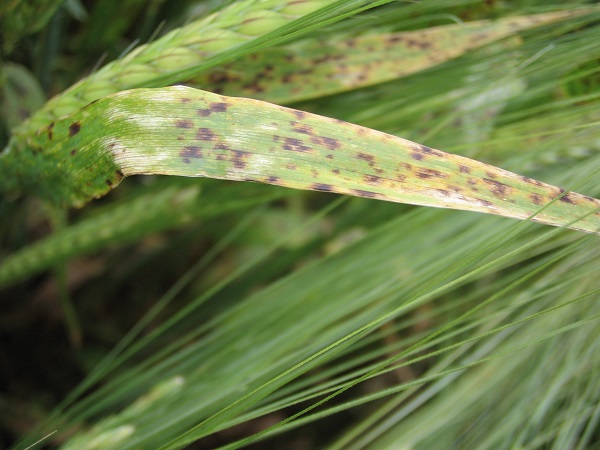In this Tech Talk, SRUC’s Professor Fiona Burnett outlines the latest advice on cereal fungicide resistance management and the latest FRAG-UK guidelines. BASF is actively involved in closely monitoring SDHI and triazole sensitivity shifts across Europe and is fully engaged in the best advice to ensure long term fungicide performance.
Tech Talk, SRUC’s Professor Fiona Burnett outlines the latest advice on cereal fungicide resistance management and the latest FRAG-UK guidelines. BASF is actively involved in closely monitoring SDHI and triazole sensitivity shifts across Europe and is fully engaged in the best advice to ensure long term fungicide performance.
Fungicide resistance has been the hot topic over the winter period. CPM gets some clarification on the current situation and anti-resistance guidelines.
Resistance is an evolutionary change.
By Lucy de la Pasture
Fungicide resistance has been something growers have been living with for decades. It’s the natural evolution of a pathogen to find a way of surviving any chemical assault and easier where the chemistry acts on a single target site.
But recently the emphasis on fungicide resistance has changed. Tightening regulations and a dramatic slow-down of new chemistry approvals means a reliance on relatively few fungicide groups, so the potential impact of loss in efficacy is now a serious threat to crop production.

The ramularia population in some areas has shown a significant shift to all the major groups of chemistry, apart from CTL.
The discovery of a number of septoria mutants which could impact SDHI efficacy in 2015, including one (C-H152R) that was very insensitive, was a game-changer. It highlighted the need for adoption of anti-resistance strategies to help prolong the life of the two fungicide mainstays – azoles and SDHIs.
There’s been differing views on how best to manage fungicide resistance and Prof Fiona Burnett, chair of the Fungicide Resistance Action Group (FRAG-UK) provides some clarity on the issue.
What’s meant by fungicide resistance?
Fungicide resistance is when a pathogen shows a measurable reduction in sensitivity to a fungicide in lab testing, combined with a loss of efficacy in the field.
Resistance is an evolutionary change. Fungi are constantly changing and because they reproduce frequently, this can happen quite quickly in response to an environmental change, such as application of a fungicide. The change may only be advantageous to the pathogen when the fungicide is applied, so it exerts selection pressure on the pathogen population for those that have the change – a mutant strain.
Sometimes these mutations can be disadvantageous to the pathogen under normal conditions, termed a fitness penalty. In this case, their frequency in the population will decrease when the selection pressure (fungicide use) is removed.
Relative importance of resistance mechanisms in Septoria tritici.

Enzyme target site (CYP51) or mutated target site are the most common resistance mechanisms in septoria.
Source: John Lucas
What are the mechanisms?
Fungicides have different modes of action (MOA) and within each MOA are specific target sites. These target sites are the specific enzymes in a cellular process that the fungicide-active molecule binds to, preventing essential life processes in the pathogen.
Target site activity can be likened to a lock and key mechanism – a fungicide molecule works by fitting into the lock, preventing the enzyme (the usual key) from carrying out its normal biochemical function. One of the main ways pathogens evolve resistance is by small changes to shape of the target site, meaning the fungicide can no longer bind as effectively to it, reducing its efficacy.
Another mechanism is overexpression of the target, where the pathogen produces additional target site enzyme, reducing the ability of the fungicide to bind due to the extra competition.
A further mechanism which can occur involves the efflux pump which actively transport the fungicide out of cells, reducing its concentration and hence activity. Both overexpression and efflux pump mechanisms are very energy-heavy mechanisms for the pathogen so occur less commonly.
What’s the latest situation?
All azoles have the same mode of action inhibiting sterol 14α-demethylase (CYP51). A large number of mutations in the azole target site protein have now been identified, as well as non-target site mechanisms (described above).
In wheat the efficacy of azoles appears to have stabilised over the past few seasons. This may be because the pathogen is now carrying as many mutations as it can, some have fitness penalties, while still being able to function. The introduction of SDHI chemistry and increased use of multi-sites has also helped relieve the pressure on the azoles.
The industry hasn’t yet published all its monitoring information on SDHIs, but testing shows that there were new SDHI mutations in 2017 and these and the mutations already detected from 2015 onwards were being found more commonly.
The highly resistant C-H152R strain appears to have a high fitness penalty attached to the mutation and drops away in the population over the winter, only reappearing late in the season, after selection pressure from fungicide use.
In barley there have been a number of shifts to different groups of chemistry, with rhynchosporium showing a small shift in sensitivity to the QoIs (strobilurins) and net blotch to the QoIs and SDHIs. Ramularia has made the biggest step change to both azoles and SDHIs, having already evolved resistance to the QoIs. Such a complete breakdown in azole efficacy is without precedent, so there may be a new mechanism at play. This is a concerning development because the ramularia pathogen is closely related to the septoria fungi.
Why is it important?
Due to a diminishing pool of fungicide chemistry, it’s become vitally important to preserve the efficacy of existing active ingredients and extend their useful life for as long as possible to protect against yield losses due to disease.
Resistance has occurred in herbicides due to overuse, but this is very much influenced by an individual farmer’s practice. Fungicide resistance is different because disease spores can be spread by the wind, meaning guarding against resistance is a collective as well an individual responsibility.
What are the implications?
Although new chemistry is on the horizon, there are a number of reasons why it’s essential to preserve existing chemistry, the major one being that it will be needed to help protect the new molecules.
That means further slides in efficacy over the next few years need to be prevented through the wholesale adoption of good anti-resistance management practices within commercial fungicide programmes.
Now there’s only a slow ingress of new fungicide approvals, growers need to be more careful, particularly as the expected new arrivals are single target site actives – either improved azoles or SDHIs, with only one completely new MOA in the pipeline – so any failures in their chemical class now will affect them too.
What are the FRAG-UK guidelines?
- Fungicide input is only one aspect of crop management and other integrated control measures should always be used, such as good rotations and control of volunteers which may harbour disease.
- Always aim to select varieties exhibiting a high degree of resistance to diseases known to be prevalent in your area.
- Avoid growing large areas of any one variety, particularly in areas of high disease risk where the variety is known to be susceptible.
- Only use fungicides in situations where the risk or presence of disease warrants treatment.
- Use a dose that will give effective disease control and which is appropriate for the variety and disease pressure.
- Make full use of effective fungicides with different modes of action in mixtures and alternate sprays where possible.
- Make full use of multisites.
- Ensure that mixing partners are used at doses that give comparable efficacy and persistence.
- Monitor crops regularly for disease and modify plans accordingly
- Avoid repeated applications of the same product or mode of action
- Statutory limits must be followed so never exceed the maximum recommended number of applications or dose. Guidance on labels should also be followed.
What do they mean in practice?
In practice it’s important to tailor fungicide doses to risk, modifying rates so that an early-drilled susceptible variety in a high risk region is treated with a different strategy than a late-drilled resistant variety.
Resistance is Darwinian so the more fungicide you use, the more selection pressure is exerted. So consider carefully before applying extra sprays in the programme, such as T0 or T1.5, as these can be additional drivers towards resistance, depending on the chemistry. Not all crops require a T0. Yellow rust is often the reason for an early spray, but again tailor any sprays to variety risk.
In summary, no fungicide decision should be made without thought and there shouldn’t be a blanket overall strategy. Fungicide decisions need to factor in variety and seasonal risk, historical experience and capability to spray crops at the optimum timing.
A strategy founded on robust rates and mixes
Cotswolds farmer Toby Hogsbjerg has 1000ha of arable land under his care, with soil types varying from Cotswold brash to heavy clay, with clay loams and sandy clay loams in between the two extremes.
The land he farms is in two blocks, lying just north of Burford, Oxon, with around 400ha of arable land on the Wilcote Estate, with another 600ha at Swinbrook. As a first prong to his disease management strategy, Toby has lengthened the rotation to eight years, with crops including winter and spring wheat, winter barley, oilseed rape, winter and spring linseed, as well as spring beans.
One area Toby believes in paying close attention to is making sure his crops have a sufficient supply of micronutrients. This keeps them stress free and in the best condition to resist disease. Wheat production is mostly for the milling market, with 100ha blocks of RGT Illustrious, Skyfall and Crusoe currently in the ground, along with a further block of the feed wheat Costello.
Toby has reached a compromise as far as drilling dates are concerned, with drilling commencing in early Oct with the aim of completion by the middle of the month. “Any later and we find we can’t get a decent enough crop established this high up on the Cotswold hills.”
With blackgrass to contend with, the farm makes good use of increased seed rates, but this doesn’t necessarily help his disease management, he says. “We tend to apply a fungicide at T0 because we don’t want disease established in the base of thick crops. Fire-fighting disease just doesn’t work in this part of the world.”
With 400ha of wheat, one sprayer and varieties with a RL rating of 6.7 at best for septoria, Toby feels a T0 is essential in his situation. He tends to use a preformulated mixture such as Cherokee (cyproconazole+ propiconazole + CTL) at this timing.
“It’s important not to skimp on azole rates throughout the programme. It’s particularly tempting to cut rates to fit a budget where a mixture product is used as they work out more expensive but it’s really important to keep rates high,” he stresses.
Maintaining robust rates of SDHI and azole is the cornerstone of Toby’s fungicide programme, along with using mixtures with different modes of action. “As an industry we probably tend to look too much to the cost of a fungicide treatment rather than what’s needed to do the job and this needs to change,” he believes.
At T1 he favours Adexar (fluxapyroxad+ epoxiconazole) plus CTL or Elatus Era (benzovindiflupyr+ prothioconazole) plus CTL in the more rust-susceptible varieties, followed by Librax (fluxapyroxad+ metconazole) plus CTL at the T2 timing.
He also considers good application to be an important element in his resistance-managing strategy. “Making sure sufficient fungicide to maintain efficacy lands on the plant is important so we will use adjuvants if the weather is looking at all unsettled.”
Managing fungicide resistance: top tips
- Use balanced mixtures – use an appropriate dose of partner products so they’re best able to protect one another.
- Add a multisite to the mix – this helps takes the selection pressure off the azoles and SDHIs.
- Avoid non-essential sprays – consider whether a T0 or T1.5 is really necessary, and only target at-risk fields or varieties.
Sponsor message
BASF advocates the use of cereal fungicides that balance disease control with responsible resistance management, including selecting varieties with high resistance to Septoria, using effective fungicides with different mode of actions at robust dose rates and avoiding the repeated applications of the same product or mode of action. Septoria and yellow rust control should be the focus of cereal disease control in the UK; these two diseases are at the heart of BASF’s Xemium-based cereal fungicide options, Adexar and Librax. Keep in touch with other farmers’ views and fungicide strategies via the BASF Real Results website www.basfrealresults.co.uk




